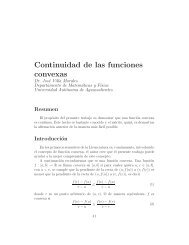Chapter 4 Linear Differential Operators
Chapter 4 Linear Differential Operators
Chapter 4 Linear Differential Operators
Create successful ePaper yourself
Turn your PDF publications into a flip-book with our unique Google optimized e-Paper software.
120 CHAPTER 4. LINEAR DIFFERENTIAL OPERATORS<br />
iii) the normalized eigenfunctions ϕn(x) = √ 2 sin nπx are complete: any<br />
function in L 2 [0, 1] has an (L 2 ) convergent expansion as<br />
where<br />
y(x) =<br />
an =<br />
1<br />
0<br />
∞<br />
n=1<br />
√<br />
an 2 sin nπx (4.43)<br />
y(x) √ 2 sin nπx dx. (4.44)<br />
This all looks very good — exactly the properties we expect for finite Hermitian<br />
matrices. Can we carry over all the results of finite matrix theory to<br />
these Hermitian operators? The answer sadly is no! Here is a counterexample:<br />
Let<br />
Again<br />
T = −i∂x, D(T ) = {y, T y ∈ L 2 [0, 1] : y(0) = y(1) = 0}. (4.45)<br />
〈y1, T y2〉 − 〈T y1, y2〉 =<br />
1<br />
0<br />
dx {y ∗ 1 (−i∂xy2) − (−i∂xy1) ∗ y2}<br />
= −i[y ∗ 1y2] 1 0 = 0. (4.46)<br />
Once more, the integrated out part vanishes due to the boundary conditions<br />
satisfied by y1 and y2, so T is nicely Hermitian. Unfortunately, T with these<br />
boundary conditions has no eigenfunctions at all — never mind a complete<br />
set! Any function satisfying T y = λy will be proportional to e iλx , but an exponential<br />
function is never zero, and cannot satisfy the boundary conditions.<br />
It seems clear that the boundary conditions are the problem. We need<br />
a better definition of “adjoint” than the formal one — one that pays more<br />
attention to boundary conditions. We will then be forced to distinguish<br />
between mere Hermiticity, or symmetry, and true self-adjointness.<br />
Exercise 4.3: Another disconcerting example. Let p = −i∂x. Show that the<br />
following operator on the infinite real line is formally self-adjoint:<br />
Now let<br />
H = x 3 p + px 3 . (4.47)<br />
ψλ(x) = |x| −3/2 <br />
exp − λ<br />
4x2 <br />
, (4.48)




